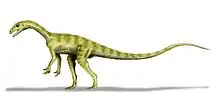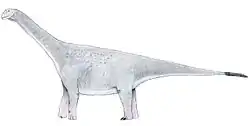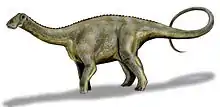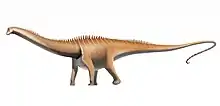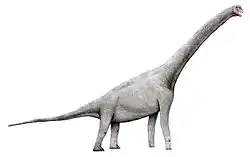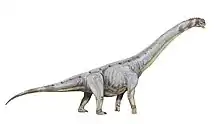Lessemsauridae
Lessemsauridae is a clade of early sauropod dinosaurs that lived in the Triassic and Jurassic of Argentina and South Africa. A phylogenetic analysis performed by Apaldetti and colleagues in 2018 recovered a new clade of Sauropodiformes uniting Lessemsaurus, Antetonitrus, and the recently described Ingentia which they named Lessemsauridae. Lessemsaurids had highly pneumatic cervical and dorsal vertebrae, very antero-posteriorly short but tall cervical vertebrae, robust cervicals, a very expanded distal scapula blade, and upright arms. Depending on the definition of Sauropoda, the clade is either the oldest sauropod taxon, or the sister taxon of the clade. An additional member of the clade was named later in 2018, Ledumahadi. Lessemsaurids are recognised as very large quadrupeds that achieved giant sizes (up to 12 metric tons) independently of other giant sauropods.[1][2] The phylogenetic analysis performed by Müller, 2019 is shown below:[3]
| Sauropodiformes |
| |||||||||||||||||||||||||||||||||||||||||||||||||||||||||||||||||||||||||||||||||||||||||||||||||||
| Lessemsaurids | |
|---|---|
 | |
| Skeletal mount of Lessemsaurus | |
| Scientific classification | |
| Kingdom: | Animalia |
| Phylum: | Chordata |
| Clade: | Dinosauria |
| Clade: | Saurischia |
| Suborder: | †Sauropodomorpha |
| Clade: | †Sauropoda |
| Clade: | †Lessemsauridae Apaldetti et al., 2018 |
| Genera | |
References
- McPhee; et al. (2018). "A Giant Dinosaur from the Earliest Jurassic of South Africa and the Transition to Quadrupedality in Early Sauropodomorphs". Current Biology. 28 (19): 3143–3151.e7. doi:10.1016/j.cub.2018.07.063. PMID 30270189.
- Apaldetti, Cecilia; Martínez, Ricardo N.; Cerda, Ignatio A.; Pol, Diego; Alcober, Oscar (2018). "An early trend towards gigantism in Triassic sauropodomorph dinosaurs". Nature Ecology & Evolution. 2 (8): 1227–1232. doi:10.1038/s41559-018-0599-y. hdl:11336/89332. PMID 29988169.
- Müller, Rodrigo Temp (2019). "Craniomandibular osteology of Macrocollum itaquii (Dinosauria: Sauropodomorpha) from the Late Triassic of southern Brazil". Journal of Systematic Palaeontology: 1–37. doi:10.1080/14772019.2019.1683902.
